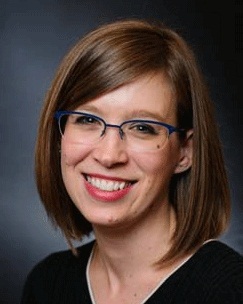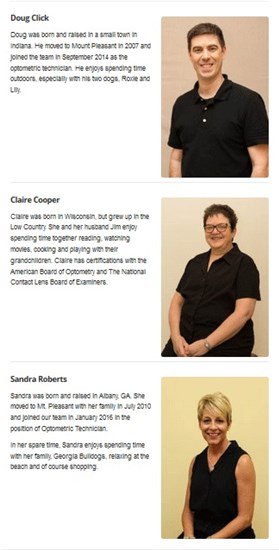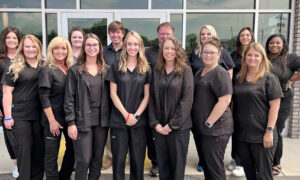By Rachael Click, OD
Nov. 30, 2016
Independent practices close every day, and employees lose their paychecks. You can never stand still in this fast-changing world. A practice only works if the whole team, doctors and support staff together, works.
I make my staff an integral part of every practice-wide effort, including our continual push to build on our already high revenue-per-comprehensive exam, $395.
Three of Dr. Click’s support staff members, as featured on her practice web site. Dr. Click says sharing your practice finances and metrics with employees creates a team spirit in which profitability is more likely.
Talk Revenue-Per-Patient at Staff Meetings
We talk about one of the most central metrics of practice success: revenue-per-comprehensive exam at every weekly staff meeting. We discuss pointers to success and areas for improvement.
For instance, Our revenue-per-comprehensive exam for the month of October this year was tracking lower than usual. My practice is located near Charleston, S.C., and we had recently experienced Hurricane Matthew. So, we had a lot of pandemonium and anxiety in the community for about a week, which may have affected our patient visits and sales of eyewear. At the staff meeting following that challenging time, I asked each staff member to identify the one thing they would do differently for the rest of the month to get the revenue-per-comprehensive exam back on track. We recorded everyone’s plan, and held each other accountable.
Give Staff the Big Picture
I recently started sharing the practice’s pre-tax net percentage, and the team was shocked at how expensive it can be to operate a business. I have always shared the top line items of our profit and loss statement, but when I share the bottom line percentages, it has a big impact on how the team thinks. We also talk about cost-of-good percentages, so the team can set a budget for ordering frames and keeping contact lens inventory correctly allocated.
I currently have three sections of practice finances that the staff is responsible for keeping track of. The front desk is responsible for tracking receipts, production booked, production kept and shopper conversion. We utilize an Excel spreadsheet from our consultants that will calculate the receipts per patient once these numbers are inserted. I have the clinic track the number of Wellness scans that we preform. The Wellness Scans are the Optos Daytona and the Optovue iWellness. The optical department tracks number of people purchasing eyewear, annual supply of contacts, anti-reflective treatments, Transitions, sunglasses and multiple pairs.
Then, we discuss all the practice stats collectively at our weekly business meeting to track our goal progress.
Incentivize
I tie practice-wide bonuses of $125/month per person to meeting the receipts goal for the month. In doing this, I have found it makes everyone work together as a team because we see how all areas of the production cycle play into achieving the overall goal.
For example, when we decided to try to increase the daily disposable contacts prescribed, it took practice, communication and years of work to get to the 50 percent fitting level we are at now. When we first started working on this, we had the rep talk to the contact lens coordinator and doctor to explain how they have seen the best practices do it. We then came up with a couple of questions that we wanted to ask our patients, and started there. The open-ended questions allowed us to have conversations with our patients about their apprehension, and values, related to their contacts.
As the doctor, I always explain to patients that I respect their habits, and have found it easier to prescribe contacts that fit their current wearing habits. If they are over-wearing their contacts, then I ask them to try the daily disposable contacts for 1-2 weeks without pressure or commitment. All I ask in return is for them to give me their honest feedback. When I started doing this, giving patients two brands of daily disposable contacts to try for the week, our fit rate success increased dramatically. Now our team conversations are built around the questions we need to start asking to increase our current fit rate success. The more you ask, the more you learn, and the more you are able to think about how to keep growing it.
Train Staff to Ask Patients Questions
You need to identify the areas that you want to improve and have a team discussion to determine what your open-ended questions should be.
For instance, I always prescribe Transitions lenses, but I have the optical department ask about what features and colors are important to the patient to help decide between Signature 7, XtraActive and Vantage. The addition of graphite green has been helpful for teenagers, and the more we learn about blue light protection the more we can educate patients on how Transitions is designed for both outdoor and indoor protection.
Use Vendors to Aid Staff Training
Partnerships of all kinds are extremely important, including those we’ve built with the vendors we purchase eyewear and contact lenses from. The more the vendors develop a partnership with the team, the more knowledgeable we are, and therefore, the more comfortable and confident we are in prescribing their products.
We rely on our frame vendors to make sure the most current and best-selling frames are on our boards. We rely on our contact lens vendors to educate us on their products and current rebates. We rely on our lab vendor to help us with product knowledge, and even doctor-driven dispensing training. Our CooperVision rep has been awesome at setting up time to educate our lead contact lens technician, who then disseminates the information to the team during our weekly business meeting.
However, we have had to take the initiative ourselves in getting educated on frames and spectacle lenses, rather than relying heavily on vendors. We take the lead in conducting research, and sometimes call our main lab to ask questions.
Our alliance, Vision Source, has been helpful in receiving education on frames and lenses. One of the biggest benefits to the sponsored Vision Source meeting is that the frame and spectacle lens reps educate us, and we can then take that information back to the team. Another key Vision Source member benefit is free access to Essilor’s ECP University. There are many training videos for all areas of the practice. These videos have been great at teaching my staff how best to educate patients about the products I prescribe.
Market Your Products to Patients
Our internal marketing is product point-of-purchase materials from the rep and verbal patient education. I have tried to train my staff in a way that everyone has a shared responsibility to help meet each patient’s needs. For example, if a contact lens patient in pre-testing is complaining of dry eye, then the technician has been trained to discuss the benefits, and the value, of a one-day contact lens modality.
Ask Patients Open-Ended Questions
We try to have conversations with our patients and ask open-ended questions. I have found the key to success with open-ended questions is that you ask in a conversational tone to build trust and feedback. Once you have the patient’s trust, then you can steer the questions in the direction you want the patient to make their purchases, thus we have a lifestyle questionnaire on the initial paperwork or online form (for those who choose to fill it out online ahead of time). The most important questions are: “What do you do for fun?” “What do you do for work?” and “How do you protect your eyes from UV damage/sun?”
We also have a small intake form that allows the staff to communicate with my associate and I about what the patients like or dislike about their contacts.
In the exam room, I like to follow-up with a question such as “What do you like and dislike about your current glasses?” Or: “What would you change about your contacts?” My practice fits about 45-50 percent daily-disposable contacts, and we have an annual supply sale rate of 42 percent. I always ask patients how often they throw away their contacts and then explain to them that brand doesn’t matter, but it is important to follow the brand’s guidelines to reduce the risk of infection. I then explain to them that our lives revolve around doing things daily. I send them home with two brands of daily-disposable lenses, and ask them to try both brands, and wear their favorite brand to their follow-up appointment.
Rachael Click, OD, is the owner of Preferred EyeCare Center in Mount Pleasant, S.C. To contact her: drclick@preferredeyecarecenter.com.




























